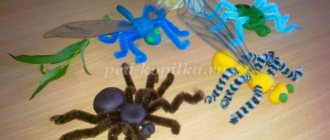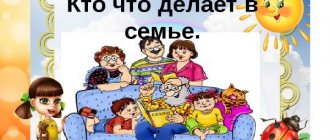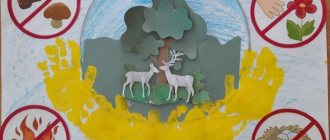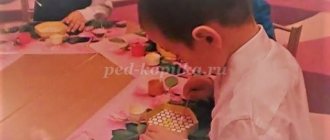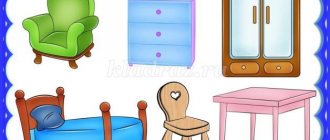Junior group. Early childhood, nursery. Children 1-4 years old
Notes for a lesson on speech development “How the hares cooked borscht” in the first junior group. Notes for a lesson on speech development “How the hares cooked borscht.” " (1st junior group)
Purpose: to consolidate the name of vegetables; name their main external characteristics, distinguish them by appearance. Introduce children to cooking. Develop skills of cooperation and mutual assistance. Enrichment…
GCD in the early age group “Visiting the Forest Dwellers”
Goal: developing ideas about nature and wild animals. Objectives: • Continue to introduce children to wild animals (hare, bear, their habits (hare jumps, bear waddles). • Develop active speech, attention and visual-effective thinking. • Develop...
Montessori classes to develop a sense of order for children 2-3 years old
Such exercises help the child understand the principles by which our world exists; mainly here we work on sorting and classification.
Find a pair - Montessori classes for 2-3 years old
The principle of pair selection can be very widely used in working with children:
- Invite your child to sort his own socks and gloves.
- Print out images of animals and offer to compare the picture with existing toy models (the same can be done with your favorite cars, flowers, building models, etc.)
- Offer to find paired cards (colors, images, textures),
- Use special Montessori materials for 2 years and older
Sorting – complicated Montessori games for children from 2 years old
When the baby has mastered pairs, you can move on to a more complex option - sorting.
- Sort cards of different shades by color (you can cut pictures from magazines, scraps, colored cardboard, or you can buy a ready-made Montessori set),
- Remember Cinderella and offer to sort out different types of cereals. First, it is better to take larger grains: beans, chickpeas. Children's breakfast cereals with their cereals, pillows and rings can also be convenient,
- Sort out the box with grandma's buttons by shape, color or number of holes (you definitely have one!)
- Ask your child to put the cutlery in its place,
- Offer to clean up the kitchen and put all the cylinders and balls in one direction, and the cubes and parallelepipeds in the other,
- Rewind the salad: cucumbers to cucumbers, tomatoes to tomatoes, and so on
Establishing Montessori Sequences for a Child 3 Years and Under
- Lay out cards with simple stories and ask your child to remember the correct sequence of events.
- Use Montessori cylinders to help your child master the concepts of less-more and lower-higher,
- Learn simple self-care steps, breaking them down into steps. This way you can learn how to brush your teeth, take a shower, care for animals, and get ready for kindergarten.
Abstract of the educational activity “Our favorite kindergarten” for the younger group
Abstract of the educational activity “Our favorite kindergarten” for the younger group
Educational area:
“Social communicative development”
Goal:
To form children’s knowledge about the world around them;
Objectives: Educational:
• Formation of readiness for joint activities with peers and adults, • Formation of social and communicative speech skills.
Developmental:
• Develop friendly relations in children towards kindergarten, • Development of cognitive activity;
• Develop the child’s emotional sphere, speech, thinking, memory. Educational:
• Cultivate positive emotions that create a cheerful, cheerful mood.
To form a feeling of sympathy for peers, a friendly attitude, and a willingness to respond to the request of an adult - teacher. Preliminary work:
Reading works of fiction about the rules of behavior in kindergarten, about friendship, looking at illustrations: “We are in kindergarten”, didactic games: “Emotions”, “Locomotive of Emotions”;
conversations: “We are friendly guys”, “What is kindergarten?” Expected result: Children will develop a positive attitude towards kindergarten, difficulties in communicating with adults and peers will be overcome. Org. Moment Educator:
(
invites the children into the circle)
I recognized all the children I called you into the circle with me We will all hold hands and smile at each other To make it more fun
Pass on the mood quickly (the teacher smiles in the mirror, the children pass the mirror around with a smile) Educator :
— “You and I shared a good mood with each other, let’s smile at each other.”
While a song about kindergarten is playing, the teacher brings the Bouncing Bunny toy into the group. (The teacher speaks for the Bunny) Bunny:
“Hello, kids!
I'm the Bouncing Bunny. Tell me, please, where did I end up?” Children:
This is a kindergarten.
Bunny:
“Kindergarten, what is kindergarten?
And what is it for? (Photo of the kindergarten) Educator:
- “Guys, let’s help Bunny find out what a kindergarten is?”
Children:
Children's answers
Main part
Educator:
“Whoever finds it.
Where is the photo of the kindergarten in our group?” - Children search on their own (Sit the children in a semicircle on chairs. Place a bunny. Magnetic board with illustrations about the kindergarten) Educator:
draws the children’s attention to a photograph of the kindergarten - What kind of building is this?
– Children’s answers: “Kindergarten” - How many floors does it have? – Children’s answers: “Two” – Who goes to kindergarten? – Children’s answers: “Children, teachers” – Why do you guys come here? – Children’s answers: “Play, eat, sleep, walk.” Educator:
“Well done guys, now Bunny knows what kindergarten looks like.
And what do children do in it?” Didactic game in a circle: “Let’s get to know each other”
Bunny:
“I also really like to play, and I know a very interesting game called “Let's get to know each other.”
Bunny:
“Guys, I suggest everyone hold hands and line up in a circle” - the teacher helps to line up in a circle, he himself stands up with the toy bunny.
Bunny:
I'll run around in a circle and extend my paw. Whoever says his name will shake my paw.
The teacher with a toy in his hands walks around the children, hearing the child’s name, he repeats it out loud and adds: “It’s very nice (child’s name) I’m a Jumping Bunny.”
Bunny:
“I was very pleased to meet you,” he asks a question, addressing the children: “I want to ask you, the most interesting thing in kindergarten is playing and is there nothing else you do?”
(children’s assumption) Teacher:
“Bunny, the guys will tell you and show you what interesting things we are still doing.”
Bunny:
(addresses the children) “What interesting things can you do with those objects over there, and what are these objects?
- points to the cubes" Children:
"These are cubes, they are needed for construction."
The teacher motivates the children to independently construct with an explanation from the cubes.
Choice of building according to the children's wishes .
Bunny:
“What wonderful toys the blocks are.”
“You can use cubes to build and construct different structures.” Educational game: “Colored Rain” - in pairs Cards with colored clouds of red, yellow, green, blue according to the number of pairs of children Bunny:
Pays attention to the pencils in the cups and asks the children: - “What are these beautiful sticks, what are they for?”
(children's answers) Children:
“These are pencils, they are needed for drawing.”
Educator:
“That’s right, these are colored pencils, you can draw anything with them.” I suggest everyone choose a pair and, to the music, draw colorful rain that comes from different colored clouds.
- From the blue cloud, what kind of rain will come? - blue; - From the red cloud? - red; etc. They pronounce all the colors, do the work independently to the music, the teacher draws with the children and the teddy bear, put all the cards in a row
Bunny:
“What a beautiful multi-colored rain, how we made it” - the children’s answers: “Drawn with pencils.”
Mishka draws attention to the corner of cognition, counting materials: ducks, dogs, nesting dolls.
Bunny:
“Why do you need so many identical toys?”
Educator:
“With the help of them we learn to compare objects.” - What kind of duck is this? – big. - What kind of duck is this? - small. - It’s also interesting to count them, guys, what should we count? – children voice their choice, count: “One, two...”
Bunny:
“You guys are great at counting and you taught me”
Experimental activity: “Boats” (Container with water, paper boats) Educator:
“We love to build, draw, count, and it’s also very interesting to solve riddles and conduct experiments and experiments " - addresses the children: - How to make a boat float on the water without the help of hands?
-What can be done? - children’s suggestion to blow on the boats (children blow on the boats on their own, making them float, the bunny blows on the boats with the children.) Bunny:
“Guys, I haven’t solved the riddle, why did the boats sail?”
- children’s answers: “We blew on the boats, created the wind that made them sail” - (the teacher helps formulate the conclusion.) Didactic game: “Find the book”
Bunny:
“I’m interested in so much knowledge, where can I get it?”
Educator:
“Knowledge can be obtained from books”
Bunny:
“I don’t know what books are, show me guys” - children show the book corner - There are a lot of books, but you probably don’t have books about kindergarten.
Educator:
Children, show a book in which it is written about kindergarten (children find the one they need among the laid out books)
Educator:
Well done, there are different books, with the help of this book we will learn about the rules of behavior and the daily routine in kindergarten.
Bunny:
“Please tell me what the daily routine is in kindergarten”
Phys.
minute: “Kindergarten” Early in the morning we came, (walking in place) And everyone started playing, So that health was in order one, two, one, two We do morning exercises We wash our hands with water, before eating (imitate hand washing) Then we will learn a lot of useful, smart and interesting things, and then quickly go for a walk and play on the playground. We need to return from a walk once, twice, once, twice. Eat lunch together in peace. After sleep, go to bed sweetly. In very soft beds. For health and order, we need invigorating exercises. One, two. One, two, wake up kids; And then a game awaits us, this is how the kids live here (sit on the carpet)
Bunny:
“You guys have a very interesting time in kindergarten.”
Bunny:
“What a fine fellow you all are, already accustomed to kindergarten, to each other, but there are so many of you, you probably swear very often, fight, take away each other’s toys”;
Children:
Children's answers (if there is a difficulty, the teacher helps)
Educator:
“Bunny, we learn to be friends with the help of poems, stories, games, songs”
Educator:
I suggest everyone hold hands and make a circle of friendship
Children sing a song: “The sun has friends “
The sun has friends, it’s us, you and me. It’s good when friends are us, you and me! -2 times
Bunny:
“What a beautiful and kind song, I also want to become your friend,” he addresses the children, “will you be friends with me?”
— children’s answers RESULT
Little Bunny: “It’s time for me to go back to the forest and tell you about your kindergarten. Please remind me guys what I should tell you.” 1) Today you told me about what? – about kindergarten 2) Who goes to kindergarten? – children, teachers; 3) What do children do in kindergarten? - play, dance, sing, sleep... 4) How do children play in kindergarten? - amicably
Bunny:
“Thank you guys, you’re all so great, now I remember everything, and I’ll quickly run into the forest so as not to forget.” That’s what kind of friends we are, I’m very happy with everything, And now it’s time for me to go to the forest, Goodbye kids!
- the children say goodbye to the bunny. Educator:
“Guys, I also want to tell you that you all did great today, you answered well and worked together.
